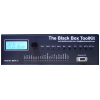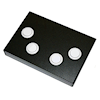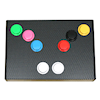Background
Millisecond timing error means that your experiment is not working as you intended and that your results might be invalid.- Are you always carrying out the experiments you assume you are?
- Are you aware of millisecond timing error in your own experiments?
- Are you confident you can replicate experiments using different hardware and software in another lab?
Are you putting your reputation at risk?
We can help
If you wish to discuss how any of our products could help you improve your research feel free to email us. Alternatively contact us by mail, phone or fax.How to improve millisecond timing in your psychology experiments
 At
the Black Box ToolKit we believe that you, the researcher, are the
one best placed to detect and correct any timing errors in your
own studies prior to publication. To enable you to accomplish this
we have developed a range of easy to use hardware and software
products that let you quickly improve your timing accuracy and
consistency.
At
the Black Box ToolKit we believe that you, the researcher, are the
one best placed to detect and correct any timing errors in your
own studies prior to publication. To enable you to accomplish this
we have developed a range of easy to use hardware and software
products that let you quickly improve your timing accuracy and
consistency.Our ethos is that researchers should reduce millisecond presentation, synchronization and response timing error to as near zero as possible. To do this you need tools that let you establish your current levels of timing error and hardware that lets you keep levels low.
Black Box ToolKit v3™
Our key product that helps you evaluate millisecond timing accuracy is the Black Box ToolKit v3 (BBTK v3). This is a hardware independent device that checks timing accuracy in your experiments when running on your own hardware in three easy steps:-
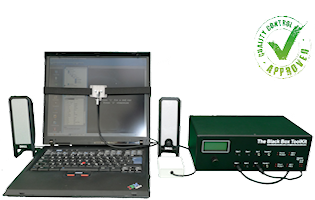 Set-up
– Hook up external stimulus sensors (opto-detectors, mics,
TTL) and a response device (response pad, robotic key
actuator, sounder, TTL)
Set-up
– Hook up external stimulus sensors (opto-detectors, mics,
TTL) and a response device (response pad, robotic key
actuator, sounder, TTL) - Test – Use a wizard to select a stimulus pattern to automatically respond to/event mark. Then choose the exact response time, response device and duration
- Analyze – Check your stimulus, response and synchronization timings across up to 36 channels. Compare what your experiment recorded with what the BBTK saw
Once you determine levels of timing accuracy you can take steps to correct any issues, e.g. moving stimuli temporally forward or backward in the presentation timeline so that they align in the real world when they physically appear.
The BBTK v3 hardware and software is used in labs across the world and encompasses Cognitive Psychology, Neuroscience, Language and Vision research among others. It is the gold standard for assessing millisecond timing accuracy, event marking and self-validation. Be sure of your research results prior to publication. Compare
mBlack Box ToolKit v2™ (event marking version)
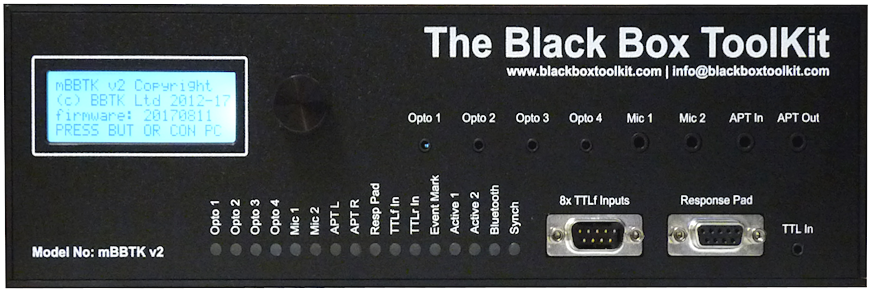 The
mBBTK v2 is an easy to use fit and forget solution for TTL event
marking in psychology experiments that use EEG, fMRI, Eye Tracking
or any study where you need to event mark with sub-millisecond
accuracy.
The
mBBTK v2 is an easy to use fit and forget solution for TTL event
marking in psychology experiments that use EEG, fMRI, Eye Tracking
or any study where you need to event mark with sub-millisecond
accuracy.The mBBTK v2 (event marking version) is designed to act as your eyes and ears and event mark exactly when a stimulus appears, a sound is made or a response button is pressed. Objective, independent and right first time every time.
With up to 48 input channels there is a sensor to cover every type of stimulus. Any input channel or sensor can quickly be paired with any of the 24 TTL event marking output lines using our PC Software. What�™s more all event marking data is simultaneously recorded in real time for later analysis.
If you want to run standalone without a PC, no problem. Simply download between 1-10 onboard profiles. Sick of wires? Then you can control the mBBTK from across the room using Bluetooth! Compare
BBTK 1-8 button USB response pad
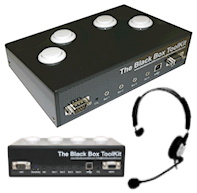 Our
USB response pad and response pad with voice key enable you to
reduce variation in your response times and increase accuracy.
They check for a button press 50,000 times per second and transmit
a standard keystroke to your experimental PC in around 60
millionths of a seconds (50kHz and 60µs respectively). This helps
ensure that you can be sure that your response device is not
adding to response inaccuracy. On the voice key model a vocal
response sends a standard keystroke to your PC.
Our
USB response pad and response pad with voice key enable you to
reduce variation in your response times and increase accuracy.
They check for a button press 50,000 times per second and transmit
a standard keystroke to your experimental PC in around 60
millionths of a seconds (50kHz and 60µs respectively). This helps
ensure that you can be sure that your response device is not
adding to response inaccuracy. On the voice key model a vocal
response sends a standard keystroke to your PC.Both types of response pad are fit and forget replacements and appear to your experiment as a standard keyboard where button presses appear as if a key had been pressed. Up to 9x TTL signals can be used for event marking button and voice key activity.
Remember although our USB response pads are millisecond accurate and help reduce response time variability in your psychology experiments they can't automatically correct for any mistimings that are inherent within the experiment generator you use. If you wish to check the accuracy and consistency of your experiment generator, or system as a whole, you are advised to use a Black Box ToolKit v3 together with a BBTK USB response pad. Compare
USB TTL event marking module
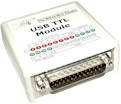 Often
it is useful to send a TTL event mark from your experiment
generator when a stimulus is shown or other event occurs, e.g. in
EEG studies. With the demise of the parallel port on PCs this has
become increasingly problematic. Our USB to TTL event marking
module enables you to event mark with ease. Designed as a parallel
port replacement and with 16 event marking lines/channels you can
send TTL events quickly and easily from the majority of experiment
generators and your own software.
Often
it is useful to send a TTL event mark from your experiment
generator when a stimulus is shown or other event occurs, e.g. in
EEG studies. With the demise of the parallel port on PCs this has
become increasingly problematic. Our USB to TTL event marking
module enables you to event mark with ease. Designed as a parallel
port replacement and with 16 event marking lines/channels you can
send TTL events quickly and easily from the majority of experiment
generators and your own software.Remember although our USB TTL event marking modules are millisecond accurate internally they can't automatically correct for any mistimings that are inherent within the experiment generator you use. If you wish to check the accuracy and consistency of your experiment generator, or system as a whole, you are advised to use a Black Box ToolKit v3 together with a BBTK USB TTL event marking module. Compare
4 port USB response box
 The
response box is designed for use in custom applications where our
1-8 button USB response pads cannot be used. It emulates a
standard keyboard and allows you to plug-in 1-4 high quality
external push-to-make buttons. When pushed a standard keystroke is
sent to the computer as though a key on a keyboard had been
pressed. It enables you to build your own custom input solutions
safe in the knowledge your accuracy isn't compromised. A TTL
signal port can also be used for event marking.
The
response box is designed for use in custom applications where our
1-8 button USB response pads cannot be used. It emulates a
standard keyboard and allows you to plug-in 1-4 high quality
external push-to-make buttons. When pushed a standard keystroke is
sent to the computer as though a key on a keyboard had been
pressed. It enables you to build your own custom input solutions
safe in the knowledge your accuracy isn't compromised. A TTL
signal port can also be used for event marking.Remember although our USB response boxes are millisecond accurate and help reduce response time variability in your psychology experiments they can't automatically correct for any mistimings that are inherent within the experiment generator you use. If you wish to check the accuracy and consistency of your experiment generator, or system as a whole, you are advised to use a Black Box ToolKit v3 together with a BBTK USB response box. Compare
Custom built devices and consultancy
 As
the Black Box ToolKit employs Psychologists, Electronic Engineers
and Programmers we can offer a wide range of bespoke services. We
have the design and manufacturing capabilities to produce one-off
custom built devices for a reasonable cost or to customize one of
our existing products for you. Need more production volume – we
can help here too. Why not ask us for a quote for custom hardware
design and manufacture or about our consultancy services in order
to take your project to the next level.
As
the Black Box ToolKit employs Psychologists, Electronic Engineers
and Programmers we can offer a wide range of bespoke services. We
have the design and manufacturing capabilities to produce one-off
custom built devices for a reasonable cost or to customize one of
our existing products for you. Need more production volume – we
can help here too. Why not ask us for a quote for custom hardware
design and manufacture or about our consultancy services in order
to take your project to the next level.